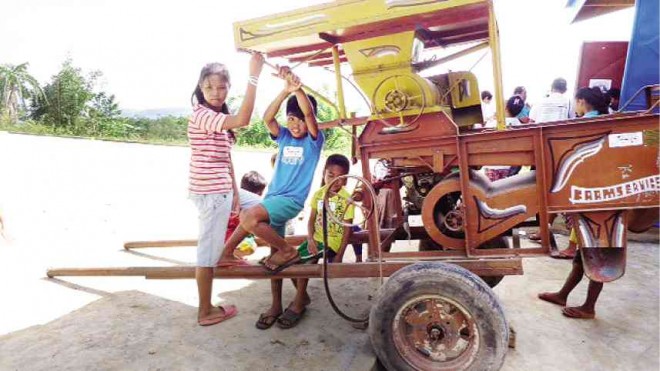In conflict areas, peace amid noise

CHILDREN play on one of the mobile corn shellers provided by the Mindanao Trust Fund for Reconstruction and Development Program to farmers in Romongaob, South Upi, Maguindanao province, as part of its support for peace-building efforts of the government in conflict-affected areas in Mindanao. FRINSTON LIM
(First of two parts)
As lawmakers wrangle over the proposed Bangsamoro Basic Law (BBL) in Manila, poor communities in areas of Mindanao that bore the brunt of armed conflict are enjoying the gains of development programs made possible by peace-building efforts of the government, the Moro Islamic Liberation Front (MILF) and international agencies.
In the past 10 years, these programs have brought changes to the lives of over half a million people in at least 12 strife-torn areas, providing jobs, empowering communities and fostering unity and harmony.
Take, for example, the upland farming village of Romongaob in South Upi town, Maguindanao province. The hilly place is home to about 5,000 people, 70 percent of whom are members of the Teduray tribe, 25 percent Christian settlers and the rest Muslims.
“Before, we did not collectively receive projects. Livelihood programs from the outside were given straight to a particular (ethno-religious) group,” said resident Noel Maningula. That changed in 2013 with the entry of the Bangsamoro Development Agency (BDA), the development arm of the MILF.
The BDA, through the Mindanao Trust Fund for Reconstruction and Development Program (MTF-RDP), helped the community put up a warehouse with solar dryer, providing farmers with mobile corn shellers and additional farm machinery.
Foreign funds
The projects cost some P3.4 million. With funds pooled from the European Union, and the governments of Sweden, Australia, Canada, United States and New Zealand, the MTF-RDP has poured in P1.3 billion since 2006 in conflict-affected villages in Mindanao.
It has supported projects giving access to basic services, such as roads, water supply systems and even toilets, as well as livelihood projects like post-harvest facilities and farm equipment.
The World Bank administers the fund on behalf of the Philippine government, the MILF and international donors.
Matthew Stephens, MTF-RDP program manager, said the program’s community-based approach “has fostered social cohesion among diverse Muslim, Christian and [indigenous peoples] communities in Mindanao.”
Communities are chosen based on how much they have suffered from the conflict and how poor they are, Stephens said.
Even areas in the core territories of the Bangsamoro, such as Pantukan, Compostela Valley, and Tarragona, Davao Oriental, were included.
Unique feature
Motoo Konishi, World Bank country director, said the MTF-RDP “is in many ways a unique project.”
“The most unique feature of the program is that it supports the [BDA]. It’s very rare for a revolutionary group to have a dedicated development arm, least of all for the development arm to cooperate directly with the government and the international community,” Konishi said.
How did the MTF-RDP-funded projects benefit the residents of Romongaob?
Isidra Batitao, who owns a hectare of cornfield in Sitio Eking, said the corn sheller had made farm work more efficient.
She said farmers paid only P10 per sack for the use of the corn-shelling facility. Traders in the town charge the farmers P160 per sack for the same service, “or else we do the shelling manually.”
A group called Romangaob Tri-People’s Organization (RTPO) administers the service fees and uses the money for repair and maintenance of the farm machinery.
People’s roles
Stephens said the beneficiaries were the ones who chose the projects for their community. People’s organizations, such as the RTPO, are responsible for maintaining the projects, he said, “so that [villagers] will feel it’s their project and not someone else’s.”
To ensure sustainability, the MTF-RDP enters into agreements with local government units (LGUs) that require the LGUs to provide counterpart funds or materials.
Of the over 311 sub-projects already completed in 214 villages in 75 municipalities across Mindanao, three out of four (75 percent) are community-based infrastructure, such as access roads, footpaths, water systems, electrification and post-harvest facilities.
At least 21 percent are income-generating programs, while the rest include shelter-related projects.
The MTF-RDP has established enough safety nets to ensure the projects are properly implemented and answer the concrete needs of communities, Stephens said.














